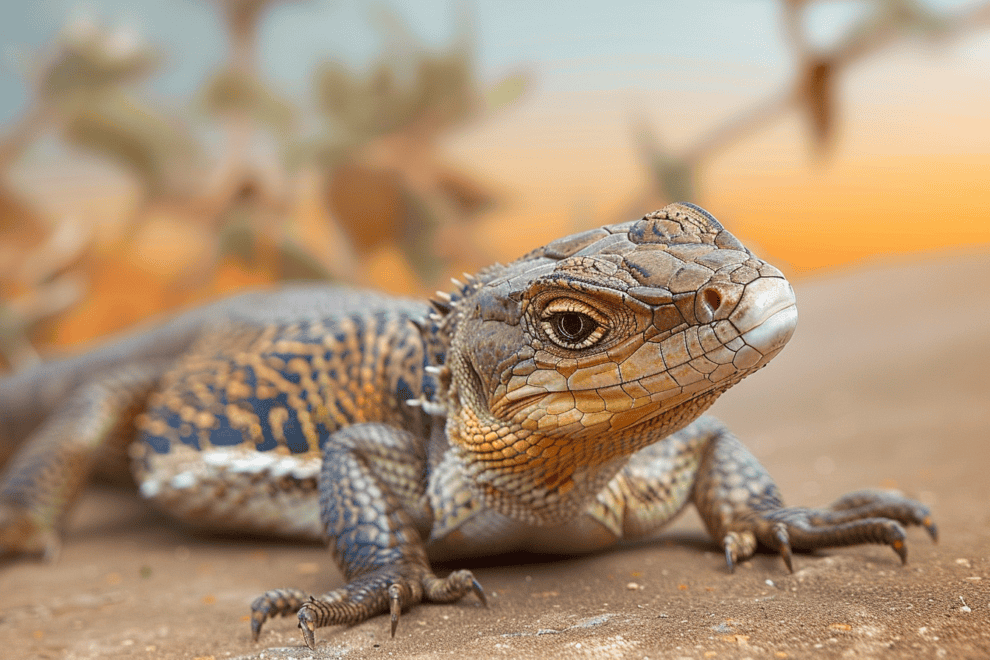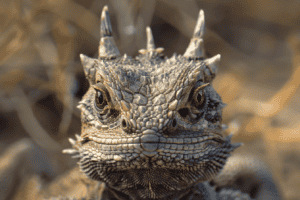Reptiles have always been known for their unique adaptations that help them survive in the wild.
One such adaptation that has fascinated scientists and nature enthusiasts alike is the ability of some reptiles to detach their skin to evade predators.
Skinks, in particular, are one such species that have mastered the art of escaping danger by shedding their skin.

Skinks are fascinating creatures that belong to the family Scincidae. They are small, cylindrical lizards with smooth, scaly skin and functioning eyelids.
Skinks have a unique defense mechanism that allows them to detach their skin when in danger. This process, known as autotomy, allows them to escape while leaving the predator with a wriggling tail as a distraction.
The detached skin continues to move for a short period, diverting the predator’s attention and buying precious seconds for the skink to flee to safety.
This incredible adaptation has made skinks one of the most successful reptile escape artists in the animal kingdom.
In this article, we will delve deeper into the world of reptile escape artists and explore the fascinating world of skinks and their detachable skin.
The Secret World of Skinks

Understanding Skink Biology
Skinks are a fascinating group of lizards belonging to the family Scincidae. These reptiles are known for their smooth, shiny skin and small legs.
Skinks have a unique ability to detach their tails from their bodies when threatened by predators, allowing them to escape and regenerate their tails over time.
Skinks are found in a variety of habitats, including forests, grasslands, and deserts, and they play an important role in the ecosystem as predators of insects and other small invertebrates.
They are also preyed upon by many animals, including foxes, raccoons, snakes, and birds of prey.
One of the most interesting features of skinks is their bright and colorful tails. These tails serve as a defense mechanism, distracting predators from the skink itself. Juvenile skinks have even brighter tails, which help them to escape from predators more easily.
Skink Species and Their Habitats
There are many species of skinks, each with their own unique characteristics and habitats.
The Blue-Tongued Skink is a popular pet lizard known for its distinctive blue tongue and large size. This species is found in Australia and is often found in grasslands and open woodlands.
The Five-Lined Skink is a common species found throughout North America. This skink has distinctive stripes running down its back and is often found in wooded areas or near water sources.
The Blue-Tailed Skink is another species found in North America. This skink has a bright blue tail that it uses as a defense mechanism, dropping it to distract predators. The Blue-Tailed Skink is often found in forested areas and is an important predator of insects and other small invertebrates.
Plestiodon fasciatus, also known as the Common Five-Lined Skink, is a species of skink found in North America. These skinks are known for their ability to regenerate their tails if they are damaged or lost. They are often found in forested areas and near water sources.
How Skinks Evade Predators

Skinks are fascinating creatures that have developed a unique defense mechanism to evade predators. When threatened, they can detach their skin and flee, leaving their predator with a mouthful of skin and a confused look on their face.
This process is known as autotomy, and it is a stress response that allows the skink to escape unharmed.
The skink’s detachable skin is a marvel of evolution. It is made up of specialized cells that allow it to separate from the underlying tissue without causing harm to the skink.
This ability to shed skin is a survival mechanism that has evolved over millions of years, and it is an effective way for skinks to avoid becoming a meal for predators.
The Phenomenon of Tail Shedding
Tail shedding is another common defense mechanism used by reptiles to evade predators. This phenomenon is most commonly observed in lizards, such as the spiny-tailed iguana and the small reptiles called captorhinids that lived 289 million years ago.
When a predator grabs a lizard’s tail, the lizard can detach its tail and escape, leaving the predator with a wriggling tail and a confused look on its face.
Tail shedding is a survival mechanism that has evolved over millions of years. It allows lizards to escape from predators and survive to reproduce. This phenomenon is still observed in some modern-day lizards, such as the gecko, which can shed patches of skin and scales from most of its body when threatened.
Skinks and lizards are not the only animals that have developed unique defense mechanisms to evade predators. Raccoons, crows, herons, and hawks are also masters of escape. These animals have evolved to be fast, agile, and cunning, allowing them to evade predators and survive in the wild.
Living with Skinks

Creating a Safe Skink Environment
When it comes to keeping skinks in captivity, creating a safe and comfortable environment is crucial.
Skinks are active creatures that require plenty of space to roam around and explore. A glass terrarium is an ideal enclosure for skinks as it allows for easy observation and maintenance.
The enclosure should be large enough to provide a temperature gradient, which means that one side of the enclosure should be warmer than the other. This allows the skinks to regulate their body temperature by moving to the side that suits them best.
The substrate used in the enclosure should be coconut coir or another substrate that can hold humidity. This is important as skinks require a humid environment to thrive.
Leaf litter and plants can be added to the enclosure to provide hiding places and enrich the skink’s environment. It’s important to avoid using any plants that are toxic to skinks, such as ivy or oleander.
Diet and Care in Captivity
Skinks are insectivores, which means they primarily feed on insects such as crickets and worms.
In captivity, it’s important to provide a varied diet that includes a range of insects, as well as fruit and vegetables.
It’s important to avoid feeding skinks any insects that have been caught in the wild, as they may have been exposed to pesticides or other harmful chemicals.
Fresh water should be provided at all times, and the enclosure should be misted regularly to maintain humidity levels.
Skinks also require a source of UVB lighting to help them produce vitamin D3, which is essential for calcium absorption.
Frequently Asked Questions
How does the ability to shed skin help skinks avoid predators?
Skinks are known for their unique ability to detach their tails from their bodies when they are under attack. This natural defense mechanism allows them to escape from predators and survive.
When a predator grabs hold of a skink’s tail, the lizard can voluntarily shed its skin, leaving the attacker with a wriggling tail as a distraction.
The detached tail continues to move for a short period, diverting the predator’s attention and buying precious seconds for the skink to flee to safety.
What’s the process behind a lizard’s tail regeneration, and what is it called?
The process of tail regeneration is called autotomy. When a skink sheds its tail, a new one begins to grow in its place.
The regeneration process takes time, and the new tail may not look exactly like the original. The new tail may be shorter, thicker, or have a different coloration than the original. However, it serves the same purpose, and the skink can still use it to protect itself from predators.
Do lizards feel pain when they lose their tails, and how do they cope with it?
Lizards do not have the same type of pain receptors as humans, so they do not feel pain in the same way. However, they may experience some discomfort or stress during the tail shedding process.
After shedding their tails, lizards may become more cautious and move more slowly until their new tails have fully grown back.
Is there a limit to how many times a lizard can regrow its tail, and what factors affect this?
Most lizards can only regrow their tails once. However, some species, such as the leopard gecko, can regrow their tails multiple times.
The frequency of tail regeneration depends on several factors, including the age and health of the lizard, the extent of the injury, and the availability of resources for regrowth.
In what ways do lizards use their tails to protect themselves from threats?
Lizards use their tails for several purposes, including balance, communication, and defense.
When threatened, lizards can use their tails to distract predators, allowing them to escape. Some lizards may also use their tails to lash out at attackers, delivering a painful blow with their powerful muscles.
Apart from tail shedding, what other defense mechanisms do skinks have?
In addition to tail shedding, skinks have several other defense mechanisms. Some skinks can change their coloration to blend in with their surroundings, making them less visible to predators. Others may puff up their bodies or make loud noises to scare off attackers.
Some skinks may even release a foul-smelling substance to deter predators from attacking them.









